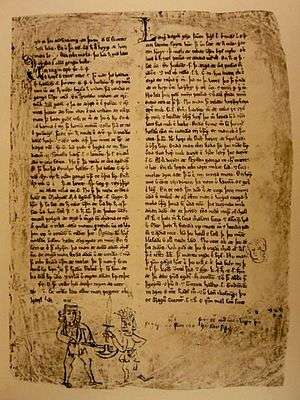Sturlunga saga

Sturlunga saga (often called simply Sturlunga) is a collection of Icelandic sagas by various authors from the 12th and 13th centuries; it was assembled in about 1300. It mostly deals with the story of the Sturlungs, a powerful family clan during the Age of the Sturlungs period of the Icelandic Commonwealth.
Sturlunga saga covers the history of Iceland between 1117 and 1264.[1] It begins with Geirmundar þáttr heljarskinns, the legend of Geirmundr heljarskinn, a regional ruler in late 9th-century Norway, who moves to Iceland to escape the growing power of King Harald Finehair.[2] The more historical sagas commence in 1117 with Þorgils saga ok Hafliða. Other sagas included in the collection are Sturlu saga, Prestssaga Guðmundar Arasonar, Guðmundar saga biskups, Hrafns saga Sveinbjarnarsonar, Þórðar saga kakala, Svínfellinga saga and Íslendinga saga, composed by Sturla Þórðarson, which constitutes almost half of the compilation and covers the period 1183–1264.[1] The compiler assembled the components in chronological order, added þættir including Geirmundar þáttr and Haukdæla þáttr and genealogies, and endeavoured to combine them into a single work, usually replacing the beginning and the ending with a linking passage.[3] In some cases he broke up sagas to achieve chronological order.[1][4]
Sturlunga saga is the main source of Icelandic history during the 12th and 13th centuries and was written by people who experienced the internal power struggle which ended in Iceland's loss of sovereignty and submission to Norway in 1262–64; the descriptions of wounds in Íslendinga saga are so detailed that they may be based on eyewitness accounts used in compensation claims.[5] It is also indispensable for the details of social history which it contains.[1] Indirect evidence suggests that it was compiled by Þórðr Narfason (d. 1308),[6] who may also have written Geirmundar þáttr and Haukdæla þáttr and possibly also Sturlu þáttr.[1]
The work is preserved in somewhat differing versions in two defective Western Icelandic parchments dating to the second half of the 14th century, the Króksfjarðarbók and the Reykjafjarðarbók (AM 122 a fol. and AM 122 b fol.),[2] and in 17th-century paper manuscripts derived from these. The former also contains material from Hákonar saga Hákonarsonar; the latter contains interpolations from Þorgils saga Skarða and also contains Sturlu þáttr and two sagas which are not usually counted as part of Sturlunga saga, Jartegna saga Guðmundar biskups and Arna saga biskups.[1][3]
References
- 1 2 3 4 5 6 "Sturlunga saga", Rudolf Simek and Hermann Pálsson, Lexikon der altnordischen Literatur, Kröners Taschenausgabe 490, Stuttgart: Kröner, 1987, ISBN 9783520490018, pp. 339–41 (German)
- 1 2 Jan de Vries, Altnordische Literaturgeschichte, Volume 2 Die Literatur von etwa 1150 bis 1300; die Spätzeit nach 1300, Grundriss der germanischen Philologie 16, 2nd ed. Berlin: de Gruyter, 1967, OCLC 270854789, p. 308 (German)
- 1 2 Sverrir Tómasson, "Old Icelandic Prose", in A History of Icelandic Literature, ed. Daisy Neijmann, Histories of Scandinavian Literature 5, Lincoln, Nebraska / London: University of Nebraska, 2006, ISBN 978-0-8032-3346-1, pp. 64–173, 84–85.
- ↑ For details of all the components, see de Vries, pp. 308–13.
- ↑ Sverrir, p. 85.
- ↑ de Vries, p. 313.
Further reading
- Peder Erasmus Kristian Kaalund, ed. Sturlunga saga efter Membranen Króksfjarðarbók udfyldt efter Reykjarfjarðarbók. Kongelige Nordiske oldskriftselskab. 2 vols. Copenhagen/Kristiania: Gyldendal, 1906, 1911. OCLC 812627729 (Danish)
- Jón Jóhannesson, Magnús Finnbogason and Kristján Eldjárn, eds. Sturlunga saga. 2 vols. Rejkjavík: Sturlunguútgáfan, 1946. OCLC 8056161 (Icelandic)
- Sturlunga Saga. Tr. Julia H. McGrew. 2 vols. The Library of Scandinavian Literature, The American-Scandinavian Foundation. 9–10. New York: Twayne, 1970–74. ISBN 9780805733655.
- Stephen Norman Tranter. Sturlunga saga: The rôle of the Creative Compiler. Doctoral dissertation, University of Freiburg, 1985. Europäische Hochschulschriften Reihe I, Deutsche Sprache und Literatur, 941. Frankfurt/New York: Lang, 1987. ISBN 9783820495027.
- Lois Bragg. "Generational tensions in 'Sturlunga saga'". Arkiv för nordisk filologi NS 112 (1997) 5–35.
- Guðrún Nordal. "To Dream or Not to Dream: A Question of Method". in: The Fantastic in Old Norse/Icelandic Literature: Sagas and the British Isles. Ed. John McKinnell, David Ashurst and Donata Kick. Durham: Centre for Medieval and Renaissance Studies, Durham University, 2006. ISBN 9780955333507. pp. 304–13.
External links
- Sturlunga Saga, including the Islendinga Saga of Lawman Sturla Thordson and Other Works Edited with prolegomena, appendices, tables, indices and maps by Dr. Gudbrand Vigfusson. Oxford: Clarendon Press. 1878.
- Sturlúnga-Saga edr Íslendinga-Saga hin mikla: Volume 1. Volume 2, Part 1. Volume 2, Part 2 Edited with a preface in Icelandic and Danish by Bjarni Þorsteinsson. Published in Copenhagen by Þorsteinn Einarsson Rangel: 1817, 1818 and 1820 respectively.
- Geirmundar þáttr heljarskinns (Old Norse text based on Gudbrand Vigfusson's edition) translated into English as The Tale of Geirmund Deathskin Dead link